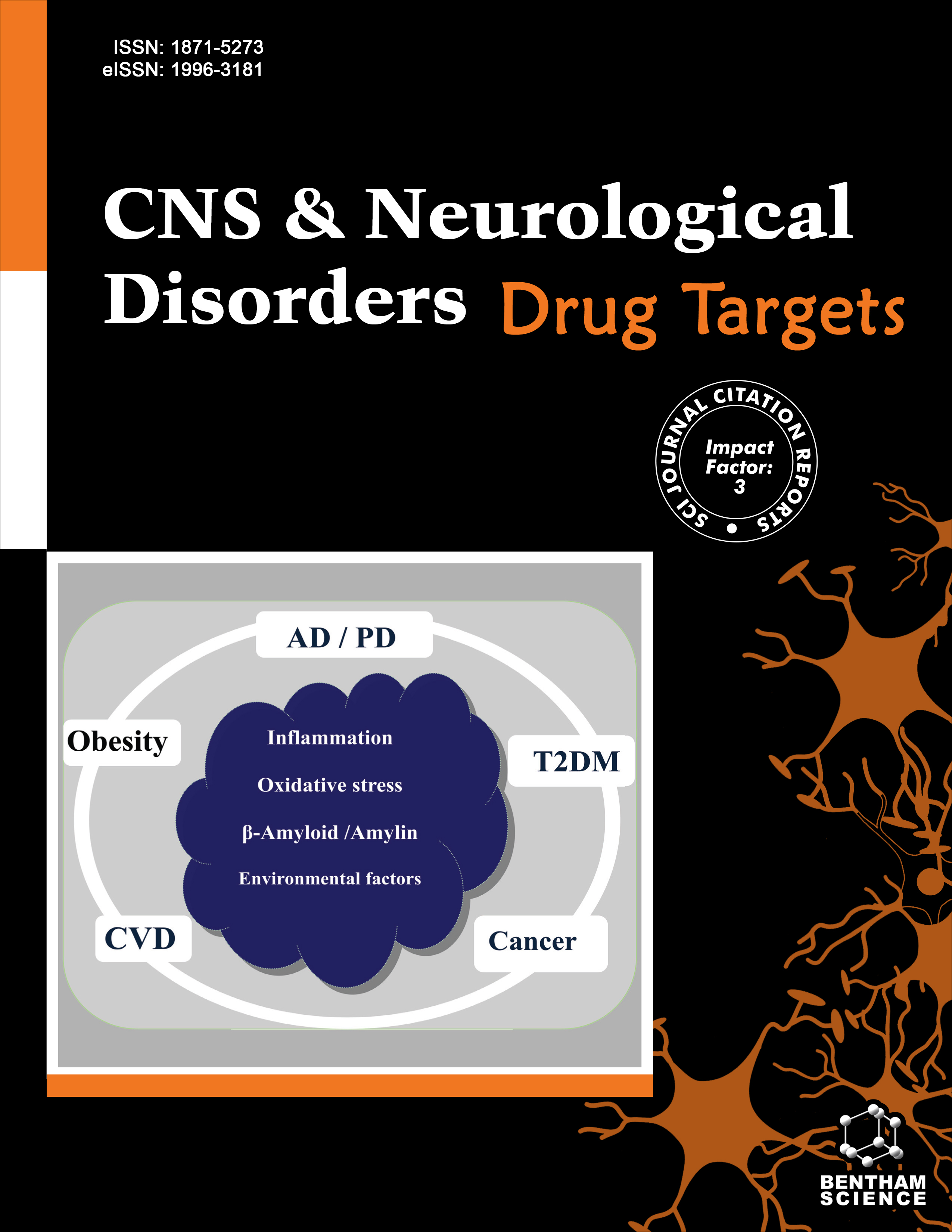- Home
- A-Z Publications
- CNS & Neurological Disorders - Drug Targets (Formerly Current Drug Targets - CNS & Neurological Disorders)
- Previous Issues
- Volume 17, Issue 8, 2018
CNS & Neurological Disorders - Drug Targets (Formerly Current Drug Targets - CNS & Neurological Disorders) - Volume 17, Issue 8, 2018
Volume 17, Issue 8, 2018
-
-
Therapeutic Advancement in Alzheimer Disease: New Hopes on the Horizon?
More LessAuthors: Ajeet Singh, Abshar Hasan, Sakshi Tiwari and Lalit M. PandeyBackground & Objective: Over the last two decades, Alzheimer disease (AD) associated research has accomplished an overwhelming momentum, as it is one of the major current healthcare issues in the developed world. AD is characterized by the presence of Aβ mediated extracellular amyloid fibrils and tau-mediated intracellular neurofibrillar tangles and reports have highlighted their subsequent effects on neuronal synaptic ac Read More
-
-
-
Overview of the Recent Advances in Pathophysiology and Treatment for Autism
More LessAuthors: Hamidreza Famitafreshi and Morteza KarimianBackground & Objective: Autism is a developmental disorder that manifests itself in early childhood. Autism is characterized by inability to acquire social skills, repetitive behaviors and failure of speech and nonverbal communication development. Recent studies have shown that genetic mutations occur in majority of individuals with autism. These mutations cause a variety of disorders that ultimately lead to brain disorde Read More
-
-
-
Metabolic Syndrome and Its Effect on the Brain: Possible Mechanism
More LessAuthors: Nurul 128;Ain Arshad, Teoh S. Lin and Mohamad Fairuz YahayaBackground & Objective: Metabolic syndrome (MetS) is an interconnected group of physiological, biochemical, clinical and metabolic factors that directly increase the risk of cardiovascular disease, type 2 diabetes mellitus (T2DM) and mortality. Rising evidence suggests that MetS plays a significant role in the progression of Alzheimer's disease and other neurodegenerative diseases. Nonetheless, the factors linking this ass Read More
-
-
-
The Dopaminergic Dysfunction and Altered Working Memory Performance of Aging Mice Lacking Gamma-synuclein Gene
More LessBackground: It was previously shown that inactivation of gamma-synuclein which is a small soluble neuronal protein affects psycho-emotional status and cognitive abilities in knock-out mice. Objective: Determine the role of gamma-synuclein inactivation on memory performance in aging animals. Method: We used the passive avoidance test and acute amphetamine administration in aging gammasynuclein knock-out mice. Read More
-
-
-
In Silico Analyses for Key Genes and Molecular Genetic Mechanism in Epilepsy and Alzheimer's Disease
More LessAuthors: Xiao-wen Jiang, Hong-yuan Lu, Ziru Xu, Tian-yi Liu, Qiong Wu, Yue Yang, Qing-chun Zhao and Hui-yuan GaoBackground: Epilepsy and Alzheimer's disease are common neuropathies with a complex pathogenesis. Both of them have some correlations in etiology, pathogenesis, pathological changes, clinical manifestations and treatment. Objective: This study investigated the key genes and molecular genetic mechanism in epilepsy and Alzheimer's disease by bioinformatics analysis. Method: Two gene expression profiles were used to s Read More
-
-
-
Serum Interleukin Levels and Insulin Resistance in Major Depressive Disorder
More LessBackground & Objective: Major depressive disorder (MDD) has been associated with inflammatory processes, including increased cytokine levels, even in individuals who are otherwise physically healthy, while some MDD patients may show insulin resistance (IR). Method: However, correlations between cytokines and IR parameters have not been studied extensively in MDD. In the present study, we measured IL-1β, IL-4, IFN-γ, T Read More
-
-
-
Serum Tryptophan, Tryptophan Catabolites and Brain-derived Neurotrophic Factor in Subgroups of Youngsters with Autism Spectrum Disorders
More LessBackground: There is evidence that changes in neuro-immune responses coupled with dysfunctions in serotonin metabolism underpin the pathophysiology of autism spectrum disorders (ASD). Objective: This study aimed to delineate whether ASD subgroups or characteristics show aberrations in tryptophan and brain-derived neurotrophic factor (BDNF) metabolism. Methods: 65 individuals with ASD (diagnosed accor Read More
-
Volumes & issues
-
Volume 24 (2025)
-
Volume 23 (2024)
-
Volume 22 (2023)
-
Volume 21 (2022)
-
Volume 20 (2021)
-
Volume 19 (2020)
-
Volume 18 (2019)
-
Volume 17 (2018)
-
Volume 16 (2017)
-
Volume 15 (2016)
-
Volume 14 (2015)
-
Volume 13 (2014)
-
Volume 12 (2013)
-
Volume 11 (2012)
-
Volume 10 (2011)
-
Volume 9 (2010)
-
Volume 8 (2009)
-
Volume 7 (2008)
-
Volume 6 (2007)
-
Volume 5 (2006)
Most Read This Month
Article
content/journals/cnsnddt
Journal
10
5
false
en

Most Cited Most Cited RSS feed
-
-
A Retrospective, Multi-Center Cohort Study Evaluating the Severity- Related Effects of Cerebrolysin Treatment on Clinical Outcomes in Traumatic Brain Injury
Authors: Dafin F. Muresanu, Alexandru V. Ciurea, Radu M. Gorgan, Eva Gheorghita, Stefan I. Florian, Horatiu Stan, Alin Blaga, Nicolai Ianovici, Stefan M. Iencean, Dana Turliuc, Horia B. Davidescu, Cornel Mihalache, Felix M. Brehar, Anca . S. Mihaescu, Dinu C. Mardare, Aurelian Anghelescu, Carmen Chiparus, Magdalena Lapadat, Viorel Pruna, Dumitru Mohan, Constantin Costea, Daniel Costea, Claudiu Palade, Narcisa Bucur, Jesus Figueroa and Anton Alvarez
-
-
-
- More Less

